Borrower owing reports
It is possible to generate Borrower Owing letters and emails (containing details of the borrower fines and fees listed in the Borrower Financial Transactions screen).
- From the Borrower Details screen, select Borrower > Financial:
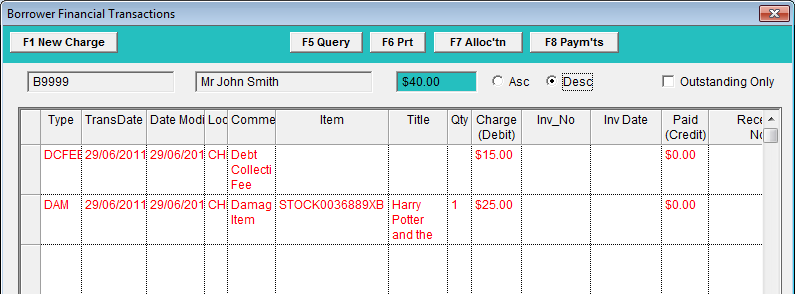
The report uses the &FINOWE.QRP and &FINOWEE.QRP templates, which can be customised (if required). The following guide takes you through the entire process for loading the customised template/s*, creating a new report and running the report.
Report Template
- &FINOWE.QRP – Borrower Owing Notice (Letter)
- & FINOWEE.QRP – Borrower Owing Notice (Email)
Save the Template*
- Save the customised template into the Amlib/Reports folder on the Amlib server. This will make the template available for use for all users. Alternatively, you may save it into a local folder on your PC – but please be aware, that the template (once loaded) will only be available for use on that PC
- Ensure that the template is saved with a name that clearly identifies it as a customised borrower owing template – for example: CSFINOWE.QRP
Load the Template*
- Launch the Amlib client.
- Go to Main > Reports > RepAddNew – the Report Files window will display.
- Select Report Entity = Financial
- Click the F1 New button – the Financial – New Report File screen will display:
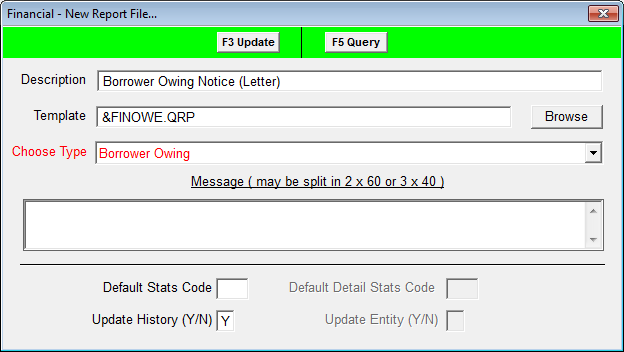
- Type in a Description – for example: Borrower Owing Notice (Letter) or Borrower Owing Notice (Email)
- Browse to the Amlib/Reports folder on your Amlib server and locate the template to be loaded (if the template has been loaded onto your PC – then navigate to the local folder)
- Files of type = Custom Report Templates (*.qrp) – if loading the standard template, select: System Report Templates (&*.qrp)
- Highlight the template to be loaded.
- Click the Open button.
- Choose Type = Borrower Owing or Borrower Owing Email.
- You can leave Default Stats Code blank.
- Update History (Y/N) = Y
- Click the F3 Update button.
- Close out of the Report Files window.
The template is now loaded and available for use in a Report.
Create the Report
- Go to Main > Reports > RepFinancial – the Financial Reports screen will display.
- Click the F1 New button – the Select Report Format screen will display.
- Highlight Borrower Owing Notice (Letter) or Borrower Owing Notice (Email) (wording may differ – it will be using the &FINOWE.QRP, &FINOWEE.QRP or a customised version of either of these templates) and click the Select button.
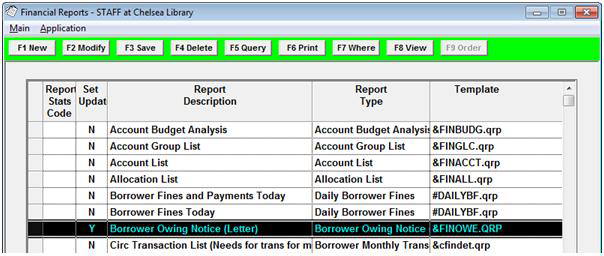
- Type in a Report Description – for example: Borrower Owing Notice (Letter) or Borrower Owing Notice (Email).
- If you would like the borrower record to retain a record of any notice sent, then ensure that Set Update = Y
- Click the F3 Save button.
Where Statement
- Highlight the report in the list and click on the F7 Where button – the Financial Reports – Where screen will display.
- The statement must include the following settings: *
- Borrower Owing – for example: Borrower Owing >= 15.00
- Financial Type – for example:
- Financial Type IS NOT NULL (click Paste without entering a value in 3), or
- Financial Type = DCFEE (this will pick up only those borrowers who have a Debt Collection Fee and owe $15 or more), or
- Financial Type IN DCFEE,DAM (this will pick up only those borrowers who have Debt Collection or Damages Fees and owe $15 or more)
Note:
Users should be careful in their use of Financial Type as a limiter, as the report will only list the financials related to the selected Financial Type/s and not any associated fines or fees – to list ALL fines and fees owing use: Financial Type IS NOT NULL See Also: The list Standard Circulation Transaction Types below.
- Additionally, you may wish to limit by Borrower Location, Barcode, Type, Group, Class or Financial Type – for example: Financial Type = DCFEE (this will pick up only those borrowers who have a Debt Collection Fee and owe $15 or more)
- (Optional – Letter Only) Always use Address 1 (Y/N) = Y
- Click on the F3 Save button.
* The fields in blue are associated fields which can be used in conjunction with the primary selection fields. These blue fields cannot be used in isolation when formulating a Where condition.
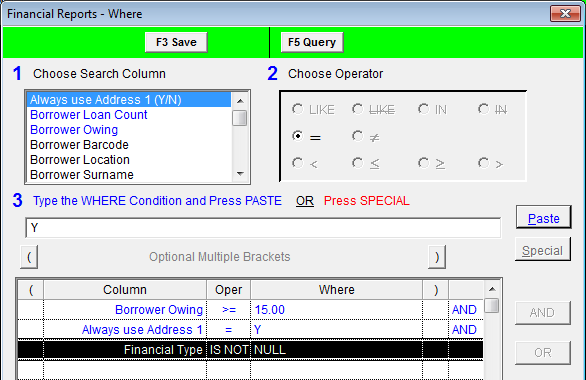
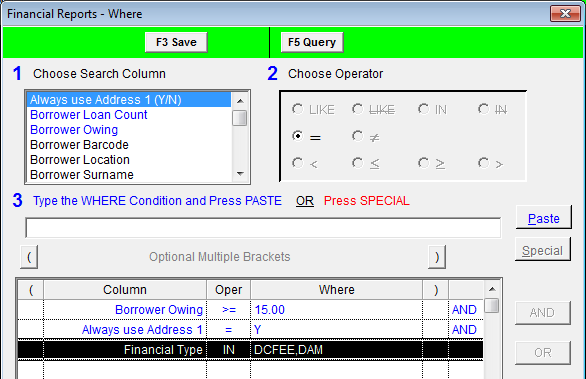
Standard Circulation Transaction Types
The following table contains the standard set of Circulation Transaction Types used in Amlib 5.3.
Please contact Amlib Support if you need further clarification.
| Circulation transaction type (standard) | Description | Credit/Debit | System use only |
|---|---|---|---|
| ACCOUNT | Account | DB - Debit | √ |
| CNH | Claims Never Had | CR - Credit | |
| CR | Claims Returned | CR - Credit | |
| DAM | Damaged Item | DB - Debit | |
| DCFEE | Debt Collection Fee | DB - Debit | √ |
| FEES | Fees | DB - Debit | |
| ISSUE | Issue Charge | DB - Debit | √ |
| LATEFINE | Fine | DB - Debit | |
| LEGAL | Legal Charge | DB - Debit | |
| LOST | Lost Item | DB - Debit | |
| OVERDUE | Overdue Item | DB - Debit | √ |
| PAYDAM | Payment for Damaged Item | CR - Credit | |
| PAYFINE | Payment for Fine | CR - Credit | |
| PAYLEGAL | Payment for Legal Charge | CR - Credit | |
| PAYLOST | Payment for Lost Item | CR - Credit | |
| RESADV | Reservation Advice Charge (through Reports) | DB - Debit | √ |
| RESCANC | Reservation Advice Charge (through Reports) | DB - Debit | √ |
| RESERVE | Reservation Charge (with Circulation) | DB - Debit | √ |
| RESFEE | Reservation Charge - Fee (through Reports) | DB - Debit | √ |
| RENEW | Renewal Charge | DB - Debit | √ |
| RETURN | Returned Item | CR - Credit | √ |
| WAIVE | Waive a Fine, Fee or Charge | CR - Credit | √ |
| WRITEOFF | Write Off a Debt | CR - Credit |
View Report
When your report is set up with the template and Where statement, you can then preview the report as follows:
- Highlight the report and click the F8 View button.
- The Select File for View prompt will display with the following message: This type of report may use a Saved File as the Source. Do you want to select the file now?

- If you would like this report to use a Saved File, click the Yes button, otherwise click the No button (generally users select the No button).
- The report will then display in the Report – View window:
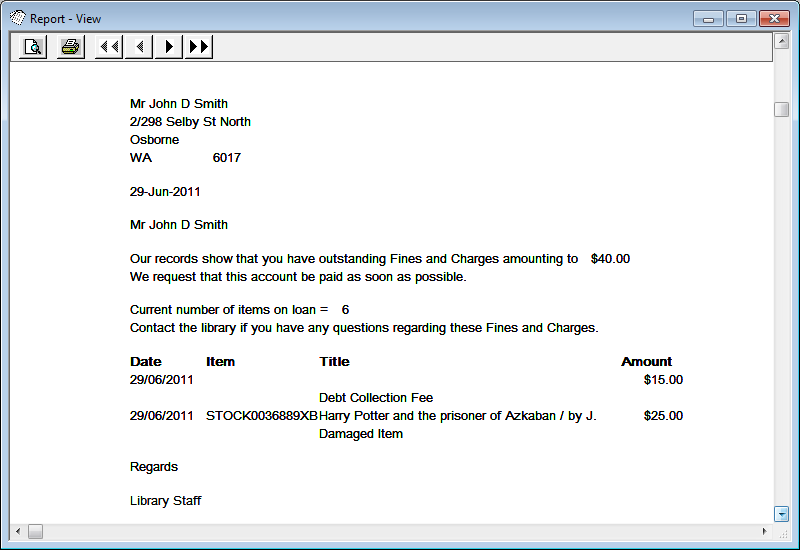
- If you wish to print a hardcopy, click on the print icon.
Print Report (via Scheduler)
If you only want to print a report then the quickest method is to use F8 View and print from the Report – View window (see above).
Using the Scheduler (via the F6 Print button) has several benefits over running reports via the F8 View button: It allows you to schedule regularly run reports so that staff do not have to do it manually each time, and it allows for further functions as part of the report such as updating Borrower/Stockitem history, updating the Reservation Status and adding report information to your statistics. Email and SMS reports MUST be run via the Scheduler.
This guide will take you through setting up a report to use RepStartSchedule.
Start the Scheduler
- From the Reports menu, select Application > RepStartSchedule.

- The Report Scheduler screen will then display.
- Select your printing options: Ensure Printing, E-mail and/or Save to File are ticked (you can tick all three if you intend on printing up multiple reports using multiple formats during a session).
- Also decide If a report is scheduled by another user do you still want to print it? = Yes/No.
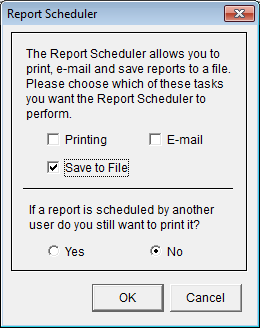
- Then click the OK button.
- After clicking OK, if you go back into the Application menu you will see that RepStartSchedule is now greyed out with a tick next to it – this indicates that the Scheduler is now running

Note: If you need to restart the scheduler at any point, you will need to log out of all Report screens (Ctrl + L) and start at the beginning of these instructions.
Schedule the Report
- With your report highlighted, select the F6 Print button – the Print dialogue box will open.
- Select from the following options:
- From:
- Database (to search the entire database)
- To:
- Printer (to generate print reports)
- E-mail (to generate email reports)
- File (to save a report as a file)
- Frequency:
- Once Only (if this is the only time you’re going to print this report)
- Daily (if you plan to send it every day)
- Weekly (if this is a once a week item)
- Monthly (if this is to be printed every calendar month)
- Every ___ days (if you want to set a specific schedule
- Schedule:
- First Print Date (the day you want this report to begin its schedule)
- First Print Time (specifies the exact minutes the report will run)
- Selected Printer:
- You can specify any active printer on the network to print to – including virtual printer drivers such as a third party software that allows you to print to PDF (For example: CutePDF Writer)
- From:
- Once you have selected all of your settings, click the OK button.
Check Print Progress
- You can check the progress of your reports at any time by going into Main > Reports > RepPrintProgress – the Print Progress screen will display.
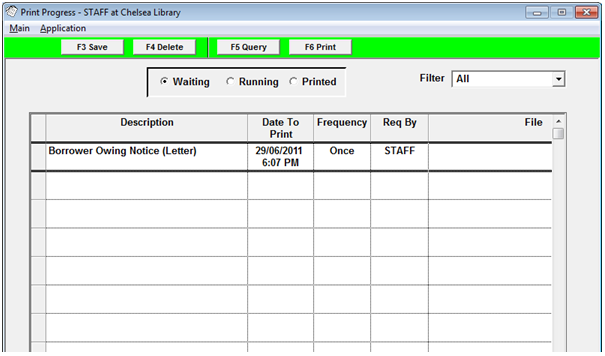
- If your library uses the scheduler for a lot of reports, you can select a frequency type from the Filter drop-down menu at the top.
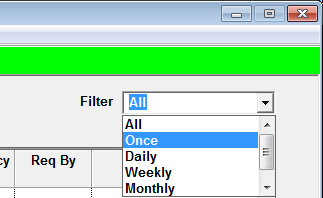
- You can also click through the three tab options at the top to see the ones that are Waiting, Running, or have already been Printed.

- Your report will show up in “Printed” when it is complete.
Additional Items
When scheduling reports, you must remember:
- The scheduler must be started prior to the time that reports are scheduled to run – you may have a procedure to start the scheduler first thing in the morning. Schedule your reports a bit later (for example: if you start at 8:30am, then schedule the first report for 9:30am) so that if there are any unforeseen delays, the print schedule will still go as normal.
- Schedule reports with time to spare. Allow time for Amlib to be started and the scheduler to be started. Allow time between scheduled reports in case you need time to refill the printer, or something else happens.
- Check and stock the printer before the reports are due to run. Scheduling reports that print to file or send e-mails are somewhat easier to manage, so you may want to try the scheduling with these first. If you are scheduling printed reports, ensure that the printer is full of paper, not low on toner and if possible have someone near the printer when the reports are due to run, so they can fix any paper jams quickly.
- Check the ‘Waiting’ queue. Old reports that have not run can jam up the print queue and stop your scheduled reports from running. It is good practice when starting the scheduler for the day to check RepPrintProgress and delete out any old print jobs from the “Waiting” queue.
- Check and maintain your “Printed” queue. A large amount of print jobs in your printed queue can stop your reports from running. While there is ample space in this area to store information on past print jobs, the space in not unlimited. If the print jobs are not deleted on a regular basis (perhaps quarterly or every few months) this area will eventually become too full to allow the reports to run. It is fine to keep some print jobs in the “Printed” area of RepPrintProgress. Perhaps keep the last few days or few weeks and delete the rest. How many reports and how often you print will determine how far back you can keep this information.
- If scheduled reports do not run for some reason (there is a paper jam or the scheduler is not started, etc.) they will sit in the “Waiting” queue in RepPrintProgress and stop other reports from printing. If there is a delay, check the “Waiting” queue. If the reports due to run have a date/time next to them that has already passed, these will need to be deleted and then manually printed via the ‘print’ button.
- Check before your re-run reports. If there was a delay or paper jam and you have to run a report for a second time, check your settings before running it. If the report creates accounts for very overdue items, running it a second time will generate a second charge – it is best to run manually via the F8 View button and then print from the view screen. Do the same if you are adding history to records or recording statistics. Reservations will require a different procedure as they will already have their status changed to “Printed”.
